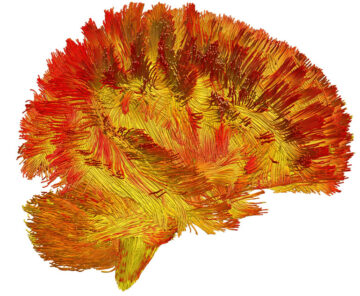
A human brain map of mitochondrial respiratory capacity and diversity
Michel Thiebaut de Schotten (CNRS, IMN), Eugene V. Mosharov et Martin Picard (Columbia University Irving Medical Center) have developed an innovative approach to bridge cellular biology and cognitive neuroscience by mapping mitochondrial function across the human brain at neuroimaging resolution.
Abstract
 Mitochondrial oxidative phosphorylation (OXPHOS) powers brain activity1,2, and mitochondrial defects are linked to neurodegenerative and neuropsychiatric disorders3,4. To understand the basis of brain activity and behaviour, there is a need to define the molecular energetic landscape of the brain5,6,7,8,9,10. Here, to bridge the scale gap between cognitive neuroscience and cell biology, we developed a physical voxelization approach to partition a frozen human coronal hemisphere section into 703 voxels comparable to neuroimaging resolution (3 × 3 × 3 mm). In each cortical and subcortical brain voxel, we profiled mitochondrial phenotypes, including OXPHOS enzyme activities, mitochondrial DNA and volume density, and mitochondria-specific respiratory capacity. We show that the human brain contains diverse mitochondrial phenotypes driven by both topology and cell types. Compared with white matter, grey matter contains >50% more mitochondria. Moreover, the mitochondria in grey matter are biochemically optimized for energy transformation, particularly among recently evolved cortical brain regions. Scaling these data to the whole brain, we created a backwards linear regression model that integrates several neuroimaging modalities11 to generate a brain-wide map of mitochondrial distribution and specialization. This model predicted mitochondrial characteristics in an independent brain region of the same donor brain. This approach and the resulting MitoBrainMap of mitochondrial phenotypes provide a foundation for exploring the molecular energetic landscape that enables normal brain function. This resource also relates to neuroimaging data and defines the subcellular basis for regionalized brain processes relevant to neuropsychiatric and neurodegenerative disorders. All data are available at http://humanmitobrainmap.bcblab.com.
Mitochondrial oxidative phosphorylation (OXPHOS) powers brain activity1,2, and mitochondrial defects are linked to neurodegenerative and neuropsychiatric disorders3,4. To understand the basis of brain activity and behaviour, there is a need to define the molecular energetic landscape of the brain5,6,7,8,9,10. Here, to bridge the scale gap between cognitive neuroscience and cell biology, we developed a physical voxelization approach to partition a frozen human coronal hemisphere section into 703 voxels comparable to neuroimaging resolution (3 × 3 × 3 mm). In each cortical and subcortical brain voxel, we profiled mitochondrial phenotypes, including OXPHOS enzyme activities, mitochondrial DNA and volume density, and mitochondria-specific respiratory capacity. We show that the human brain contains diverse mitochondrial phenotypes driven by both topology and cell types. Compared with white matter, grey matter contains >50% more mitochondria. Moreover, the mitochondria in grey matter are biochemically optimized for energy transformation, particularly among recently evolved cortical brain regions. Scaling these data to the whole brain, we created a backwards linear regression model that integrates several neuroimaging modalities11 to generate a brain-wide map of mitochondrial distribution and specialization. This model predicted mitochondrial characteristics in an independent brain region of the same donor brain. This approach and the resulting MitoBrainMap of mitochondrial phenotypes provide a foundation for exploring the molecular energetic landscape that enables normal brain function. This resource also relates to neuroimaging data and defines the subcellular basis for regionalized brain processes relevant to neuropsychiatric and neurodegenerative disorders. All data are available at http://humanmitobrainmap.bcblab.com.
Reference
A Human Brain Map of Mitochondrial Respiratory Capacity and Diversity. Eugene V. Mosharov, Ayelet M. Rosenberg, Anna S. Monzel, Corey A. Osto, Linsey Stiles, Gorazd B. Rosoklija, Andrew J. Dwork, Snehal Bindra, Alex Junker, Ya Zhang, Masashi Fujita, Madeline B. Mariani, Mihran Bakalian, David Sulzer, Philip L. De Jager, Vilas Menon, Orian S. Shirihai, J. John Mann, Mark Underwood, Maura Boldrini, Michel Thiebaut de Schotten* et Martin Picard*. Nature, le 26 mars 2025.
DOI : https://doi.org/10.1038/s41586-025-08740-6
Summary: A map of mitochondrial biology reveals the energy landscape of the human brain
https://www.nature.com/articles/d41586-025-00872-z
About it (in french)
CNRS Le Journal : https://lejournal.cnrs.fr/articles/carte-energie-cerveau-mitochondries-decouverte
Last update 27/03/25
